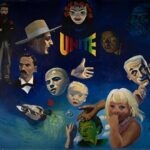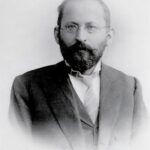
I posted earlier about the wonderful samplers of Engels letters that were either written in Eastbourne or mention Eastbourne. A local artist Solveign Geott created 7 of these samplers and they are truly exquisite. They are things of beauty. A joy forever. And in reading the extracts you can’t help but become curious about the wider picture that the letter extracts are referencing.
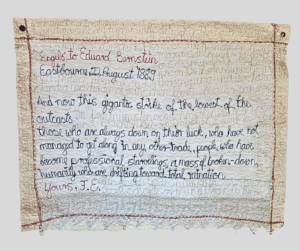
Who was Engels writing to and what were the historical events indicated by the extracts? I am no historian. I know the basics only, and even less on Marxist theory. So, I decided to begin unpicking some of this, both for my own satisfaction but also for a deeper dive for those readers who are interested. Remember, this website is not an academic resource. Our aim is to celebrate and make accessible Eastbourne’s radical history. Accessible in the sense of making it both visible but also easily understandable.
So, to this end, let’s begin with the letter extract to Eduard Bernstein written on 22nd August 1889.
Who was Eduard Bernstein?
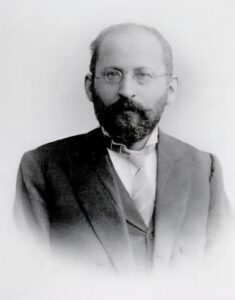
Eduard Bernstein (6 Jan 1850 – 18 Dec 1932) Creative Commons Sharealike 4.0 International
Eduard Bernstein was a German social democratic politician and socialist theorist. A member of the Social Democratic Party (SPD). He is regarded as one of the founders of modern democratic socialism and a primary figure in the history of revisionism or evolutionary socialism. Eduard Bernstein is called a revisionist Marxist because he attempted to correct Marx’s theory to account for predictions that had failed to come true. So, rather than the revolutionary predictions of orthodox Marxism, he advocated for a gradual, parliamentary path to socialism. His critique forced the international socialist movement to confront the discrepancies between theory and reality. His political and theoretical work played a significant role in the development of modern social democracy and reformist socialism.
AN ASIDE. Out of interest, Bernstein would have been 39 years old at the time of receiving the letter. Engels was nearly 70 when he wrote it. He died 6 years later. Bernstein was such a close friend that he was one of the 4 people who carried out Engels’ very last wish i.e. for his ashes to be scattered at sea. Bernstein, Frederick Lessner, Edward Aveling and Eleanor Marx took a boat on a stormy August day, from East of Eastbourne Pier to the base of Beachy Head where they scattered Engels’ ashes.
Here is the source of the short but very revealing Bernstein extract. You will also find the letter on the Brighton University Website Engels in Eastbourne…. in their selected writings section. This Bernstein letter makes for fascinating reading. Engels’ graphic descriptions and palpable excitement will leave you wanting to get to know him better. The major historical events referenced are so major “a matter of paramount important to us here” that even I knew about them, namely: –
A passing reference to the Bryant and May Match Girl Strike of 1988; the 1889 London Dock Strike; The Hyndman Procession AKA The West End Riots. (See more in this Australian newspaper article).
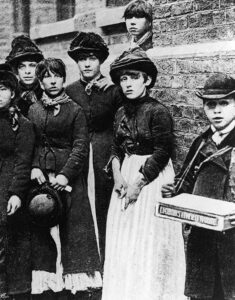
- Engels description of East End poverty:- “the East End was bogged down in passive poverty. Lack of resistance on the part of those broken by starvation, of those who had given up all hope was its salient feature. Anyone who got into it was physically and morally lost”
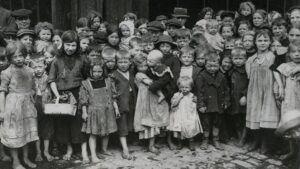
Do Check out @FactFeast for loads more videos.
- Engels’ description of the Great London Dock Strike:- “And now this gigantic strike of the lowest of the outcasts, the dock labourers — not of the steady, strong, experienced, comparatively well-paid and regularly employed ones, but of those whom chance has dumped on the docks, those who are always down on their luck, who have not managed to get along in any other trade, people who have become professional starvelings, a mass of broken-down humanity who are drifting toward total ruination, for whom one might inscribe on the gates of the docks the words of Dante: Lasciate ogni speranza voi che entrate!” (Dante: “Leave, ye that enter in, all hope behind!)”
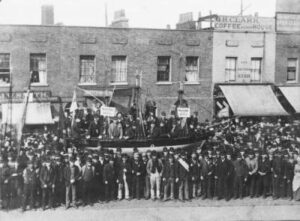
- Engels’ excitement for the strike’s success:- “And this host of utterly despondent men, who every morning when the dock gates open fight a regular battle among themselves to get the closest to the fellow who does the hiring, literally a battle waged in the competitive struggle among the much too numerous workers — this motley crowd thrown together by chance and changing daily in composition has managed to unite 40,000 strong, to maintain discipline and to strike fear into the hearts of the mighty dock companies. How glad I am to have lived to see this day!”
- Engels’ guarded hopes for the future of worker organising:- ”If this stratum can be organised, that is a fact of great import. However, the strike may end — I am never sanguine beforehand in this regard — with the dock labourers the lowest stratum of East End workers enters the movement and then the upper strata must follow their example. The East End contains the greatest number of common labourers in England, of people whose work requires no skill or almost none. If these sections of the proletariat, which until now have been treated with contempt by the Trade Unions of the skilled workers, organise in London, this will serve as an example for the provinces.”
- Engels’ distain and rejection of riotous action:- “Furthermore, for lack of organisation and because of the passive vegetative existence of the real workers in the East End, the gutter proletariat has had the main say there so far. It has behaved like and has been considered the typical representative of the million of starving East Enders. That will now cease. The huckster and those like him will be forced into the background, the East End worker will be able to develop his own type and make it count by means of organisation. This is of enormous value for the movement. Scenes like those which occurred during Hyndman’s procession through Pall Mall and Piccadilly will then become impossible and the rowdy who will want to provoke a riot will simply be knocked dead”.
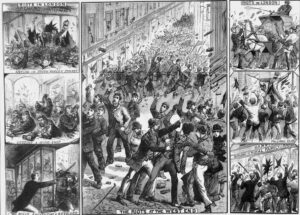
The Hyndman Procession aka “West End Riots“
Engels refers in this letter to the Hyndman’s procession otherwise known as the “West End Riots”. Here’s a description from What Next. on what occurred.
“On 8th February 1886 the Fair Trade League (a campaign formed in 1881 for trade protectionism) held a meeting in Trafalgar Square to advocate its policy of higher customs tariffs as a cure for unemployment. A counterdemonstration of the unemployed was called by the Social Democratic Federation (an avowedly Marxist organisation which was, however, repudiated by Engels, who regarded it as a sect). The SDF leaders – H.M. Hyndman, John Burns, H.H. Champion and others – treated their audience to a series of inflammatory anti-capitalist speeches. Burns, for example, was reported as telling the crowd that the House of Commons ‘was composed of capitalists who had fattened on the labour of the working man … to hang these … would be a waste of good rope … there must be a revolution to alter the state of things. The next time they met it would be to go and sack the bakers’ shops in the west of London. They had better die fighting than die starving’ .”
“…the SDF then led them on a march through Pall Mall towards another meeting in Hyde Park, with Burns at the head of the demonstration brandishing an improvised red flag. Provoked by jeering from the rich in their clubs, the demonstrators first responded by throwing stones and breaking the club windows and then set about looting shops in Piccadilly and South Audley Street. It wasn’t until the rioting had reached Oxford Street that the police belatedly intervened. Subsequently the SDF leaders were prosecuted on a charge of seditious conspiracy, but they were acquitted.”
Engels had no time of riotous behaviour he “argued that by encouraging hooliganism on the part of lumpen elements they had “done an irreparable damage to the movement”. In any case, Engels didn’t like Hyndman. He’d once insulted Marx and was never forgiven
It is interesting that 3 years later, one of the “riot leaders” was leading the London Dock Strike that had excited Engels so much. John Burns is of interest to us here on Peoples Eastbourne. The Unite panel on the International Workers Mural that use to be displayed at the TGWU Eastbourne Centre 1976, has several legendary trade union figures depicted. One of these is John Burns. That’s him top left with arms folded. Marx is hovering top right.
For a deeper dive folks, you can read about John Burns’ fascinating life here. What a working class legend. It’s truly compelling stuff. Enjoy! And for an extra deeper dive check out Rtuc’s Blog on a Short History of The Brtish Working Class Movement To The 1925 General Strike
